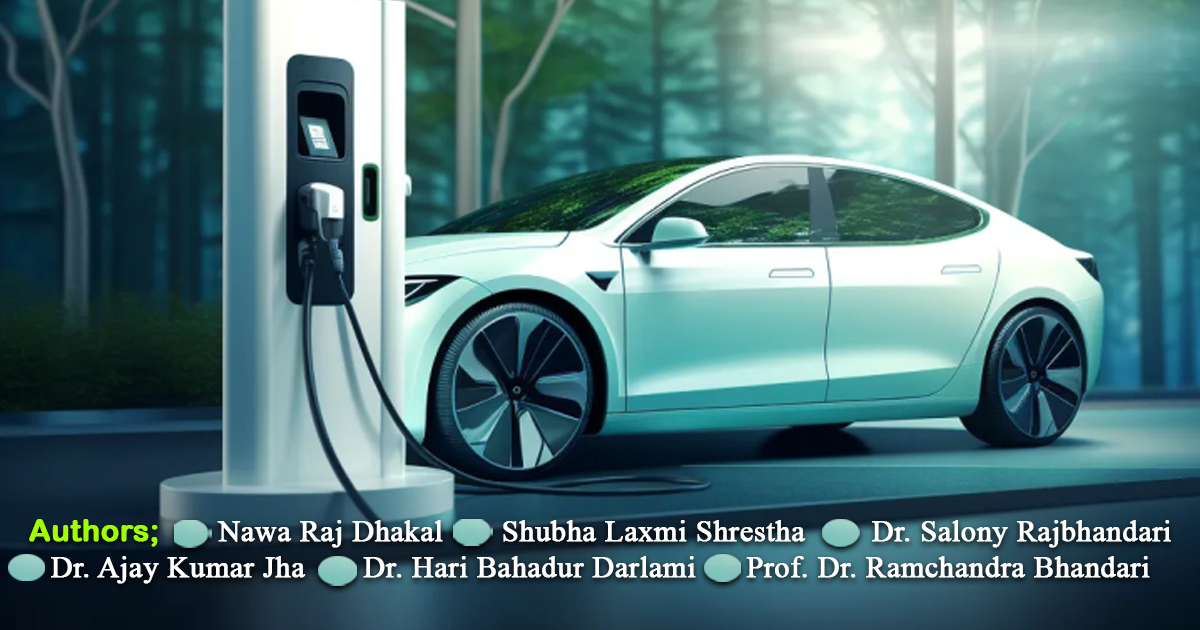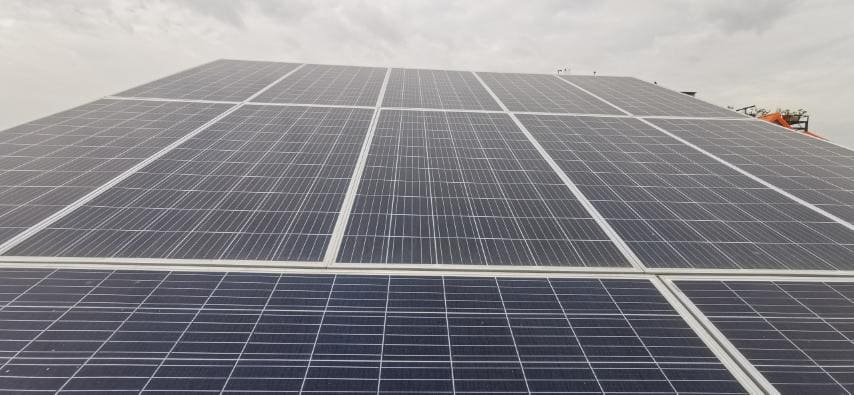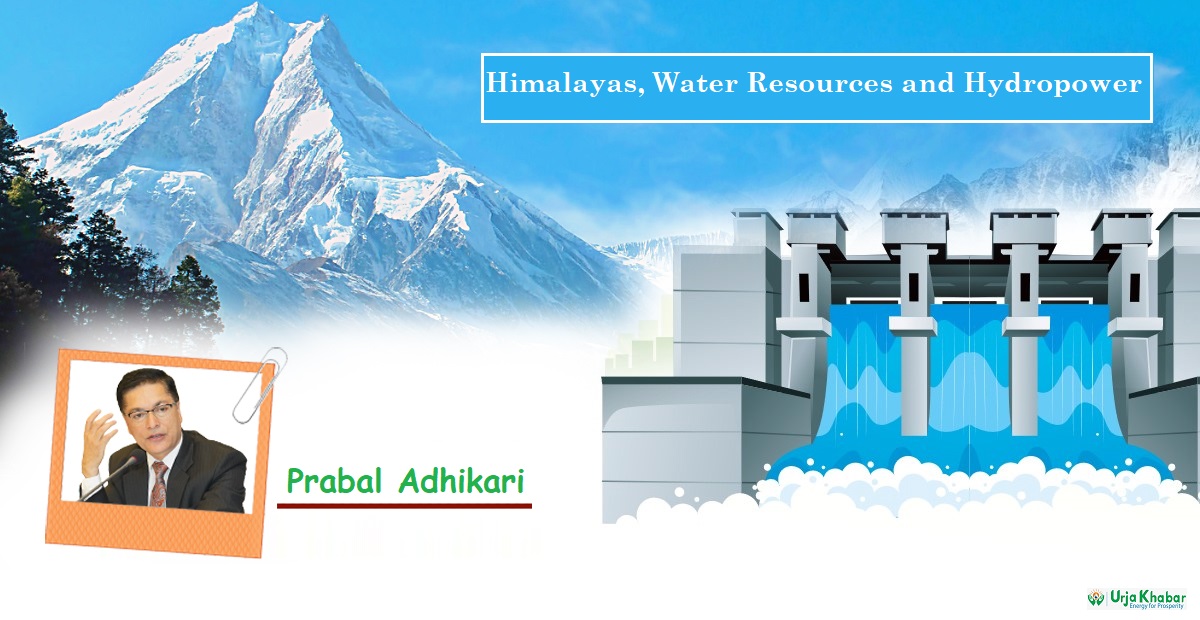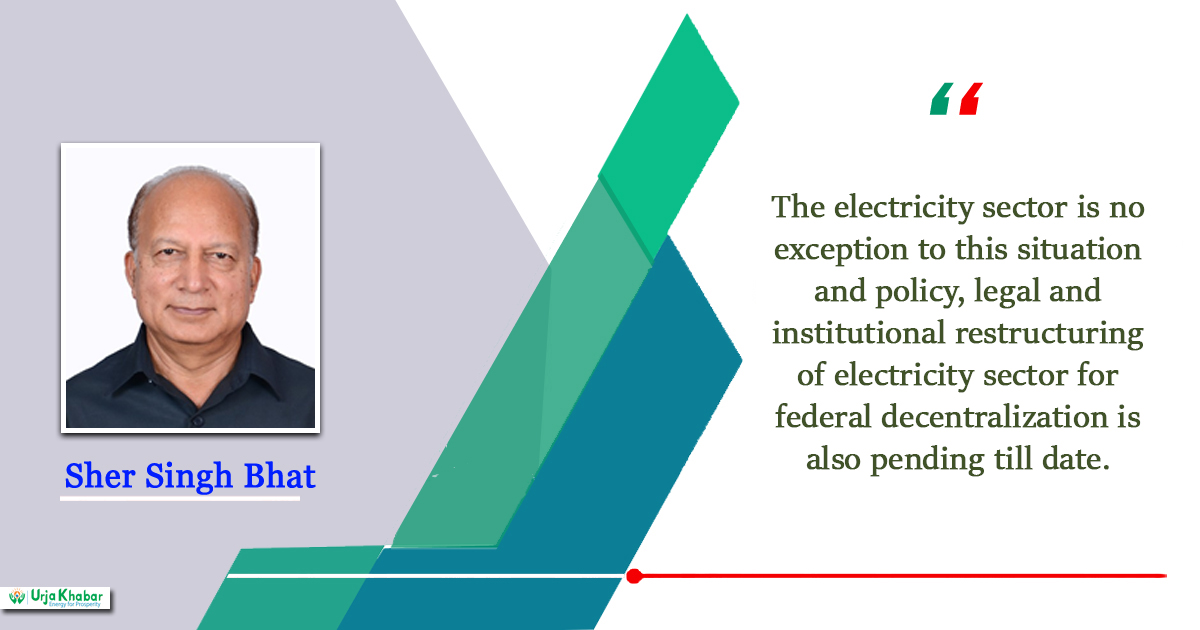Energy Update
Case Study
GHG Emissions and Electric Mobility in Kathmandu Valley's Transport Sector by 2050

Background
Globally the transportation sector is a third contributor to greenhouse gas (GHG) emissions. Out of 36.80 gigatonnes (Gt) of global energy-related carbon dioxide (CO2) emissions, 7.98 Gt was counted from the transport sector alone, making it the third largest contributor in 2022. Emissions from this sector have almost tripled due to growing populations and economies since 1970. Nepal is no exception relying completely on imported petroleum products. The capital city of Nepal, Kathmandu Valley, with its unique bowl-shaped topography faces major urban challenges including inadequate mobility and poor air quality. This article aims to quantify GHG emissions from conventional vehicles and analyze the counter role of electric mobility in Kathmandu Valley to make it a livable place.

GHGs are responsible for global warming on earth. Human induced activities - primarily fossil fuel burning, which increases heat trapping GHG levels in earth’s atmosphere - are the dominant cause behind the observed global warming since the mid-20th century. Energy is a vital commodity for economic development and a key factor for anthropogenic GHG emissions.
Nepal is among the ten least urbanized countries in the world; however, it is among the top ten countries with highest growth rate of urbanization. Kathmandu Valley, the capital and the largest city of the country, is one of the fastest growing metropolitan areas in the South Asian region. The valley is experiencing rapid and haphazard urbanization with the increasing demand for motorized travel, rising CO2 emissions, poor urban air quality and higher concentrations of particulate matter well above the World Health Organization (WHO) guidelines. Valley holds 10.4% of the country’s total population and occupies 0.5% of the total area of the country.

The unique bowl-shaped topography traps pollutants inside the valley for longer periods which is home to around three million people making it prone to adverse health effects that are not only diminishing the quality of life but also threatening the prosperity of an urban economy. As per the WHO, air pollution kills an estimated seven million people worldwide every year and every nine out of 10 people breathe air containing high levels of harmful particles. The air pollution levels in Nepal are 4.9 times higher than those recommended by the WHO. Such pollution has been consistently found to be the leading risk factor for death and disability in Nepal.
Nepal has undergone a remarkable vehicular growth, although the country is still in the early stages of motorization. The number of registered vehicles in the country grew at a rate of 14.6% during 1997 to 2021, while this growth rate exceeded 17% during the past 6 years from 2015 to 2021. Among the vehicle types, the growth in the number of two-wheelers is particularly high in the country, which grew at a rate of 16% during 1997 to 2021. Out of the total vehicles registered in Nepal, the Bagmati Province constitutes a major share of about 45%. The majority of these vehicles registered there run on the roads of Kathmandu Valley. This growth in the number of vehicles is expected to rise continuously with the increasing road infrastructure development, urbanization, motorization, and economic progress.
Domestic Energy Availability and Policies on EVs
Nepal has immense potential for generating electricity using renewable energy, especially hydropower. It can be harnessed to support the growth of electric mobility. The Government of Nepal (GoN) has committed to increase the share of electric vehicles (EVs) in transportation system through various policies such as the Second Nationally Determined Contribution (NDC); Long-Term Strategy for Net-Zero Emissions; Five-year Periodic Plan; National Transport Policy; and Environment Friendly Vehicle and Transport Policy. Explicitly, GoN aims to achieve the share of EVs to 25% and 20% for private vehicles and public passenger vehicles sales respectively by 2025, and further targets to increase the share of EVs to 90% and 60% for private vehicles and public passenger vehicles sales by 2030.
To attain the set target, GoN has introduced various policies and incentives to promote electric mobility via periodic financial legislations, including tax exemptions, subsidies, preferential treatment in registration, exemption of annual road tax, reduced custom duty, and excise duty ranging from 10-60% and 0-60% respectively. Tax holidays for domestic manufacturers of EVs are provided for 5 years with a 40% discount in trade tax. Further, a custom duty tax relaxation of up to 75% is given to import spare parts of EVs. Also, the GoN has promotional policy to convert Internal Combustion Engine (ICE) vehicles to EVs; while doing so, it charges only 1% custom duty to import the needful conversion kit. These policies have made EVs more affordable and accessible for consumers in recent years. As a result, there has been a gradual shift towards electric mobility in Nepal, with increasing adoption of electric two-wheelers, cars and buses.
Several fiscal and non-fiscal incentives have been put forward to facilitate the adoption of clean mobility across Asia. India has introduced a flagship scheme offering various incentives for promoting electric mobility and hydrogen fuel cell vehicles. India’s state level policies prevail financial incentives, waiving road tax and registration fees, establishing a wide network of charging stations and swappable battery stations, setting up of recycling ecosystem for batteries, levying of additional taxes and fees on inefficient or polluting vehicles, etc.
Maharashtra state of India has adopted policies to accelerate the adoption of battery operated EVs (BEVs) such that they contribute to 10% of new vehicle registration by 2025. India is aspiring to establish Delhi as the EV capital of the country by accelerating the pace of EV adoption across vehicle segments contributing BEV’s by 25% of all new vehicle registrations by 2024. Bangladesh proposes a 10-year tax holiday for local EV assembling and manufacturing, establishment of energy-efficient vehicle manufacturing fund to deposit fines and taxes collected from environment polluting vehicles to meet the country’s targets of transforming the majority of the passenger cars and public vehicles (mainly buses, trucks, and three-wheelers) to EV by 2030.
Likewise, China, which is the giant share-holder (47%) of EVs globally, has been promoting EVs by the urgency of reducing GHG emissions in the transport sector starting from the most polluted cities including Beijing, Shanghai, and Shenzhen. A range of monetary incentives such as financial subsidies and tax exemptions for fuel-saving capacity, mileage per charge performance, new vehicle purchase and exemption/reduction of annual vehicle tax have been implemented in China.
Non-monetary incentives such as traffic control exemptions, research and development support, license plate/registration privilege, parking fee incentive, road access privilege with city’s traffic control during peak hours have also been exercised. Chinese government has also set the rule for new vehicle manufacturing companies to compulsorily include EVs production along with petroleum vehicles.
Materials and Methods
The study conducted a primary survey, a structured survey, to estimate transport energy consumption and mobility characteristics for the base year 2022. The survey questionnaire included the information such as energy consumption along with the mobility characteristics, the socioeconomic information of the vehicle users, details of transportation registration, technical parameters like mileage, distance covered per day, fuel consumed per day, load carried etc. Besides data, the survey also provided information on barriers and hindrances for a widespread shift towards electric vehicles and the preferred mode of electric vehicles. The surveyed respondents include EV company professionals, vehicle users and national experts/policy makers. To realize the existing context and knowledge extension for future analysis, base year primary dataset collection and analysis are major contribution.
The secondary data was collected through literature. Information included such as demographics, national and provincial energy consumption, emission factors, macroeconomic data such as Gross domestic product, transport gross value added of the valley has been estimated using the proportions of GDP of the valley with respect to the national GDP provided in the National Human Development Report, and transport sector plans and policies.
This study has used the Low Emission Analysis Platform (LEAP) as the modeling tool to forecast energy consumption and to quantify the associated GHG emissions in the business-as-usual (BAU), sustainable development (SD), and net-zero emission (NZE) scenarios. Additionally, the study has estimated co-benefits, focusing on local pollutant reductions.
Results
With the present trend of increasing urbanization, motorization and development, the GHG emissions from transportation sector are estimated to increase to more than triple by 2050 in the BAU scenario, as presented in Figure 1. With the adoption of electric mobility, the SD scenario would reduce GHG emissions up to 95% in 2050. The NZE scenario foresees complete electric and hydrogen-based vehicles by 2045 with complete abatement of GHG emissions as well as local pollutants. The SD and NZE scenarios will demand 64% and 84% less energy than the BAU scenario respectively as shown in Figure 2 contributing to enhanced energy security and energy sustainability. For this, the adoption of electric mobility will demand about 1048 GWh and 1390 GWh additional electricity solely for Kathmandu Valley to achieve the SD and NZE scenarios respectively by 2050.
Co-benefits of GHG Emission Reductions
The actions to reduce GHG emissions will produce co-benefits in terms of local air pollutant reduction from the transport sector. The complete replacement of the conventional ICE vehicles with the electric and hydrogen fueled ones in the NZE scenario would also subside carbon monoxide (CO), non-methane volatile organic compounds (NMVOC), nitrogen oxide (NOX), particulate matter-2.5 (PM2.5), black carbon (BC) and organic carbon (OC) emissions. This will be a substantial relief to dwellers of the valley where local pollutants are being resident due to its bowl-shaped topography. The local pollutant CO emissions from the road transport sector in the valley are estimated to rise by 5.8 times by 2050 under the BAU scenario, while the increased electrification schemes would cause it to fall by 99% in the SD scenario. NMVOC emissions in the BAU scenario would increase more than seven folds while it would be completely abated by 2050 in the SD scenario, and from 2045 onwards in the NZE scenario. The OC, PM2.5, BC, and NOX emissions would undergo nearly eight folds, seven folds, four folds and two folds increase respectively in the BAU scenario. These local air pollutant emissions would be abated by more than 90% in the SD scenario by 2050 compared to the BAU scenario. This provides an informed decision to city planners on strategies to transform the city into a more breathable environment.
Requirement of Electricity Infrastructure
More importantly attainment of the NZE scenario requires a large increase in the number of electric vehicles, nearly 1.4 million in 2045 and 1.7 million in 2050. Thereby, the additional electricity capacity requirement would be 247 MW in the SD scenario and 327 MW in the NZE scenario in 2050. This equates to additional electricity consumption requirement of 1048 GWh in the SD scenario and 1390 GWh in the NZE scenario in 2050. The capacity addition seems to be achievable with national existing and future power system expansion plans and would be supplemented by pipeline hydro power projects. It should be noted that the pledge for NZE scenario has been driven worldwide for 2050 while Nepal optimistically has set the targets for 2045 with conditional targets.
These figures indicate that power sector development as well as the related transport sector infrastructure development should be prioritized accordingly in order to support the large-scale penetration of electric vehicles in the Valley. For this, the development of electrical infrastructure for charging stations should also be given priority. The new installation and expansion of charging stations demand high investments and sufficient space for building EV charging infrastructure, thereby imposing huge challenges for easy implementation of EVs.
Discussion on Challenges and Opportunities for Promoting EVs
Besides structured survey, broader stakeholders' consultations in presence of representatives from the National Planning Commission, different ministries, other government institutions relevant to trading/supply/generation of energy, trading/manufacturing of electric vehicles, academia/research institutes, development partners, practitioners, journalists etc. was held at the Alternative Energy Promotion Centre (AEPC), Kathmandu in April 2023 for validation as well as for further inputs of this study.
Out of the total installed electricity generating capacity of 2,190 MW about 735 MW was added into the national grid system of Nepal in FY 2021/2022 alone. This initiative has upgraded the nation into the era of surplus electricity during the wet season. This number has been in continuous rise, and it has become 3,141 MW till May 2024. Electricity generation capacity from hydropower as well as other renewable energy options (such as solar power) is likely to grow in subsequent years which can result in surplus electricity year-round. Proper planning regarding charging of EVs during off peak hours can help the country in demand management along with smoothening the load curve as well as utilization of spillage energy.
Likewise, EVs will create new jobs and avenues of local manufacturing opportunities. The increased EV promotion can contribute to technological advancements, reduce import dependence, and generate jobs in manufacturing, assembly, maintenance, and service sectors.
In contrast to massive opportunities, expansion of EVs as targeted requires sufficient electric power infrastructure. In the valley specifically, the increased penetration of EVs will increase the demands on the power network that can lead to negative consequences such as an increment of the short-circuit currents, non-standard voltage levels, reduced power quality, and accelerated aging and failure of electrical equipment.
Hence, significant reinforcement and investment in the power network will be required to ensure that the GoN’s targets are achieved. Huge challenge remains at the government side as well as at the private and public sector in leveraging resources in partnerships with international organizations for investments in charging infrastructure, providing technical expertise, establishment of repair and maintenance centers in par of ICE vehicle, support awareness campaigns, developing curriculum for EVs for wider acceptance and development of workforce needed in near future.
Further, challenges like high initial investment, very low-capacity utilization, smaller number of public vehicles, only import based technology, challenge on technology transfer locally, poor voltage profile, insufficient skilled manpower in EV industry, batteries and recycling, grid infrastructure development are to be mitigated at the par possible for sustainable EV promotion within the valley.
In recent years, the cost of EVs has been decreasing rapidly making it a competitive travel option for people in developing countries. Modern EVs can commute hundreds of kilometers along with the possibility of commuting in difficult terrain, making them a practical choice. A total of 51 EV charging stations have been installed across 33 locations all over Nepal by the Nepal Electricity Authority (NEA). Beside this, other private companies are also installing charging stations around the country.
Study done by GGGI in 2018 reveled that if BAU scenario continues in Nepal, GHG emissions at the national level will increase by two-folds in 2030 and five-folds by 2050. The transport sector nearly doubles its GHG share by 2050 (from 2005 levels). Being the nation’s cultural and political hub, the wide adoption of EVs in the valley would be hugely contributing for nation's NZE target.
Currently, Nepal incurs high economic burden as the country fulfills its petroleum fuel, ranked as top first imported commodity with the share of 18.7% of total imports, needs solely through imports. Nepal Rastra Bank published the data of this fiscal year 2023/24, for the nine first months about 218 billion NPR was spent solely on imported petroleum products. As Nepal has huge potential to develop domestic hydroelectricity, the country has immense potential to leapfrog in EV adoption.
By addressing the challenges and leveraging the mentioned opportunities, the valley can establish itself as a hub for electric mobility, contributing to sustainable and cleaner transportation and present itself as an example city for the developing countries with similar characteristics.
Conclusions
The potential role of transport sector electrification and deployment of green hydrogen fuel vehicles in GHG mitigation in the valley has been assessed during 2022 to 2050. With the present trend of development, energy consumption would undergo a fourfold increase by 2050 in the BAU scenario. Two-wheelers would remain the most prominent mode of energy consumer. The GHG emissions are estimated to undergo more than threefold increase. Aligned with the targets of both the NDC and the SDGs, there will be a huge reduction in petroleum consumption in 2050 i.e., 74% in the SD scenario and 100% in the NZE scenario.
Hydroelectricity and green hydrogen would play a major role in complete decarbonization of the transportation sector of the Valley, phasing out the petroleum fuel in the sector. By 2050, electricity is expected to contribute 82% of the total energy consumption of the transport sector of the Valley, with hydrogen fuel accounting for the remaining 18%.
GHG emissions in the NZE scenario are projected to reach 438 thousand tons by 2030 and achieve zero emissions by 2045 contributing to the national goal of achieving net-zero emissions. The complete electrification in passenger transport along with the introduction of green hydrogen fuel vehicles, particularly in hard-to-abate heavy-duty vehicles in the freight transportation sector would support in phasing out the petroleum fuels. Hence, readiness for green hydrogen fuel for vehicles will be needed well before 2045.
Since 2003, Nepal has been utilizing 100% renewable energy for electricity production. Further harnessing the untapped renewable energy potential would support the growth of electric mobility, thereby making possibility for complete decarbonization. Nepal endowed with the potential to tap 100% renewable energy, would be a sustainable solution to replace the imported fossil fuel contributing to energy security and economic prosperity in the context of an import driven economy like Nepal.
This paper serves as evidence to motivate policy implementers and city developers to enforce wide implementation of the efficient mode of electric as well as hydrogen-based vehicles. Simultaneously this study opens an avenue for further research on potential strategies for phasing out plan of conventional ICE vehicles with the needful stable national and municipal fiscal policies to realize SD and NZE targets. Having recycling plants within the country or appropriate end-life vehicle/battery management system in view of possible environmental impacts, a specific city wise investment scenario for total transport ecosystem could also be an area of further research for proper allocation of resources.
Mitigating GHG emissions in cities is crucial for achieving net-zero emissions and addressing climate change. Cities are significant contributors to global carbon emissions due to their concentrated population, energy consumption, and infrastructure. This study can act as an inspiring example and can also be replicated to other similar growing cities of developing countries for improving pollution levels and making them sustainable and habitable. Hence, this paper is expected to help policy implementers, transport planners and city administrators to develop adequate action plans and policies for improving pollution levels and making the cities of developing countries sustainable and habitable.
Reference:
Rajbhandari, S.; Shrestha, S.L.; Bhandari, R.; Jha, A.K.; Darlami, H.B. Contribution to the Net-Zero Emissions Target from the Transport Sector through Electric Mobility—A Case of Kathmandu Valley. Sustainability 2024, 16, 1211. https://doi.org/10.3390/su16031211
Author's Details
1. Nawa Raj Dhakal, Executive Director (AEPC, Nepal)
2. Shubha Laxmi Shrestha, Deputy Directorc (AEPC, Nepal); Email: [email protected]
3. Dr. Salony Rajbhandari (National Institute for Environmental Studies, Tsukuba, Japan)
4. Dr. Ajay Kumar Jha & Dr. Hari Bahadur Darlami (Institute of Engineering, Pulchowk Campus, Tribhuvan University, Nepal)
5. Prof. Dr. Ramchandra Bhandari (Institute for Technology and Resources Management in the Tropics and Subtropics, Germany
Firstly, this article had been published in an international journals (https://www.mdpi.com/2071-1050/16/3/1211).
Conversation
- Info. Dept. Reg. No. : 254/073/74
- Telephone : +977-1-5321303
- Email : [email protected]














